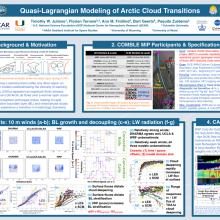Quasi-Lagrangian Modeling of Arctic Cloud Transitions
Timothy
Juliano
NSF NCAR
Poster
The Arctic is experiencing a warming trend unlike any other region on the Earth, with global climate models (GCMs) underestimating the intensity of warming. Cold-air outbreaks, or CAOs, are one of the most important weather phenomena that occur in the Arctic and sub-Arctic. CAOs are characterized by drastic airmass transformations by which cold air, originating over an ice shelf or land mass, advects equatorward over the relatively warm open ocean. Intense surface-atmosphere exchanges ensue, leading to the rapid development of a convective boundary layer and mixed-phase clouds (MPCs). These clouds often undergo a transition, which may include some combination of rolls, closed cells, and open cells depending upon a combination of factors including, but not limited to, air-sea coupling, aerosols, precipitation, wind shear, and subsidence. CAOs therefore represent an excellent testbed for studying interactions between dynamics, turbulence, and microphysics.

Juliano-Timothy-poster.pdf
(1.44 MB)
Meeting homepage
